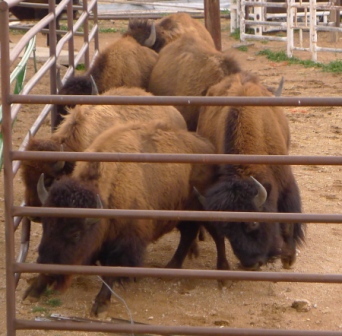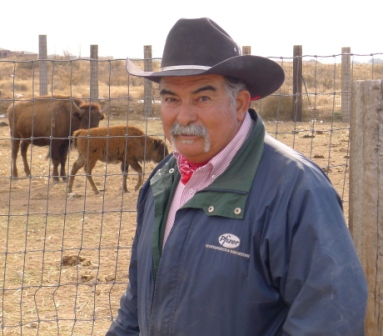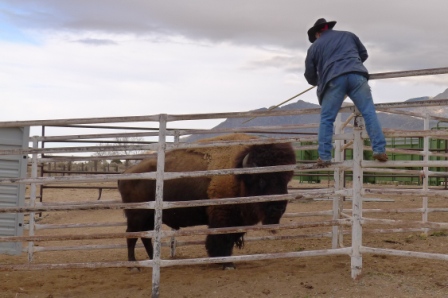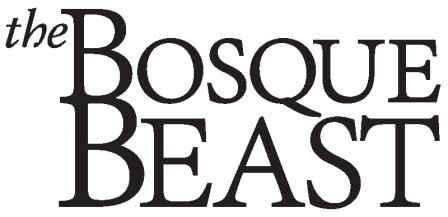A Large Charge
Even part-time buffalo wrangling makes for an all-consuming responsibility

IT DOESN'T MATTER how long your family has ranched in New Mexico, or what a big, bad cowboy you think you are. Nothing prepares you for the wrath of a one-ton buffalo who suddenly doesn’t like the way you smell.
Leroy Lovato knows. He points out a rip in the thigh of his jeans where a cow flipped him over a fence not long ago. This buffalo chased him around the feeder, followed his beeline to the fence, and threw him right over. In 15 years of tending the Sandia Pueblo buffalo herd, Lovato has developed a working mantra: “They don’t think like cattle. They don’t act like cattle.”
“It’s not just a wild animal,” he adds. “It’s prehistoric. And they act like it.”
From afar, the Sandia herd paints a picture of peace on the prairie to all who zoom by on Tramway Boulevard. Not so up close. “Right here is about as close as you want to be,” Lovato says, pointing through a fence at a few of the animals grazing nearby. From this distance, the American bison is not just an extremely large animal. What’s startling is the massive head when it turns to gaze at you—like a god’s head as tall as a human, and just as frightening.
Growing up on a Bernalillo ranch, Lovato knew nothing about buffalo when he took a part-time job as wrangler for the Pueblo. He learned by trial and error, riding the range, and talking with fellow members of the nonprofit Inter-Tribal Buffalo Council, a group that works to re-establish the buffalo’s central place on Indian lands.
He says the Sandia herd is relatively small by ITBC standards, at around 41 head, including calves. Some member tribes (58 of them in 19 states) have thousands of animals using only a fraction of their available range. In New Mexico, where drought threatens the land’s carrying capacity, it’s mostly the northern tribes that keep herds: Taos, Picuris, Pojoaque, Cochiti, as well as Laguna and Isleta. But the Sandia herd is probably the best known, as it attracts camera-toting tourists right in the heart of the state’s largest city.

TWICE WE MANAGE to catch the constantly moving Lovato on the range, and both
times he is busy herding buffalo into a livestock trailer—which you can
imagine is no small feat. Strong young men from the Pueblo arrive to
help, but they are wary of the animals, Lovato says—and with good
reason.
“They watch you, and you can’t let your guard down or they take
advantage,” he says, adding that he has learned which of the animals to
watch out for. “It’s not the bulls. It’s the alpha cow.” Dominant
females dictate the herd’s movement and even tell the bulls when it’s
time to mate, he says. You can tell which is the alpha because the
others move away when she’s nearby. “I could tell you probably the top
three cows,” he says.
Lovato created the system of chutes and corrals (with extra-high
walls) that he uses to drive buffalo into the trailer. The walls have
punctures from angry horns, and he recalls when a panicked animal tried
to jump out, and ended up wedged upside-down, and had to be freed. Even
without hearing such stories, buffalo herding is nail-biting to watch,
since there’s a point when Lovato has to run into the pen waving a prod,
trying to spook the animals into the next corral.
On this day he is culling seven bulls, which the tribe takes annually
at the new year to butcher and distribute meat to its members. The
animals are killed ceremonially, there’s a big feast, and “it’s a huge
cultural thing for the tribe,” says Lovato, who is not Native and thus
hesitates to explain the significance—though clearly it has touched him
over the years.
“I have developed a spiritual thing with them,” he admits of his
charges. Ornery and unpredictable as they may be, buffalo are highly
intelligent and imbued with certain powers, he has learned. He recalls
one year a buffalo got hit by lightning, and its carcass went untouched
by coyotes. He later told the story to a Cheyenne, who guessed that
coyotes had avoided the carcass. A divine spirit goes into the buffalo
with the lightning strike, he learned, and the skull would have held
special powers.
“Now I’m more cognizant of the stories, so I can watch for these things.”

ANOTHER COLD DAY a few weeks later, Lovato is again moving buffalo, this time
up to pasture. He normally rotates the animals among the five pastures
he established—1,000 acres in all—by shutting off their drinking water
until the herd moves. But the range has just been irrigated, and looking
after the grass is critical after the summer’s destructive rains, so
the animals are being trailered to pasture instead.
An attempt to segregate “the cow with attitude” from the rest doesn’t
work, “so we’ve gone from Plan A to Plan B to Plan Z pretty quick,”
Lovato notes cheerfully before diving back into the pen with his prod.
When buffalo get spooked and run, it feels like a stampede starting,
even when they’re two animals. They can destroy a truck in their path.
It’s no wonder the young workers like to keep a fence between them and
the herd.
“Pretty
good for 60,” Lovato grins after Plan Z had him standing on a horse
gate, trying to prod a reluctant bull into the trailer. “Did you see the
smoke off my shoes?”
DESPITE SUCH high-stress moments—or maybe because of them— Lovato loves working
with the buffalo and describes it as “therapy” for his regular
full-time job as an assessor of farm properties and livestock.
He
believes the buffalo herd is key to restoring the Pueblo’s strength and
health. “It’s so good for them,” he says. “Low in fat, high in protein
and iron. It’s good for their heart program, good for their diabetic
program. I’m hooked on the meat.” About 16 calves are born every spring,
but only six to eight animals are culled for tribal use. The rest are
sold off.
Slow-growing but steady demand for bison meat accounts for much of why
the nearly extinct animal has been able to rebound to about half a
million head in North America. Hardly any of these animals (outside
Yellowstone National Park) are genetically pure and wild, however. Most
buffalo contain cattle genes from interbreeding, which helps explain why
we now see so many of the rare “white buffalo” calves spoken of in
Indian legend. True buffalo are still considered ecologically extinct as
a wild species, according to the Defenders of Wildlife.
While they may be part-“beefalo,” the animals still retain
significance for Indian tribes as “a reminder of how they once lived
free and in harmony with nature,” according to the Inter-Tribal Buffalo
Council. Just as the Native American was conquered through destruction
of their sacred buffalo, the rebuilding of herds by ITBC member tribes
offers hope that the Indian people might rebuild their health, culture,
and buffalo spirit.
Leroy
Lovato knows that he is entrusted with a cultural legacy, and not just a
bunch of shaggy, ornery animals. That’s why he devotes a full-time
concern to his part-time job, and plans to retire from it, he says,
“never.”
